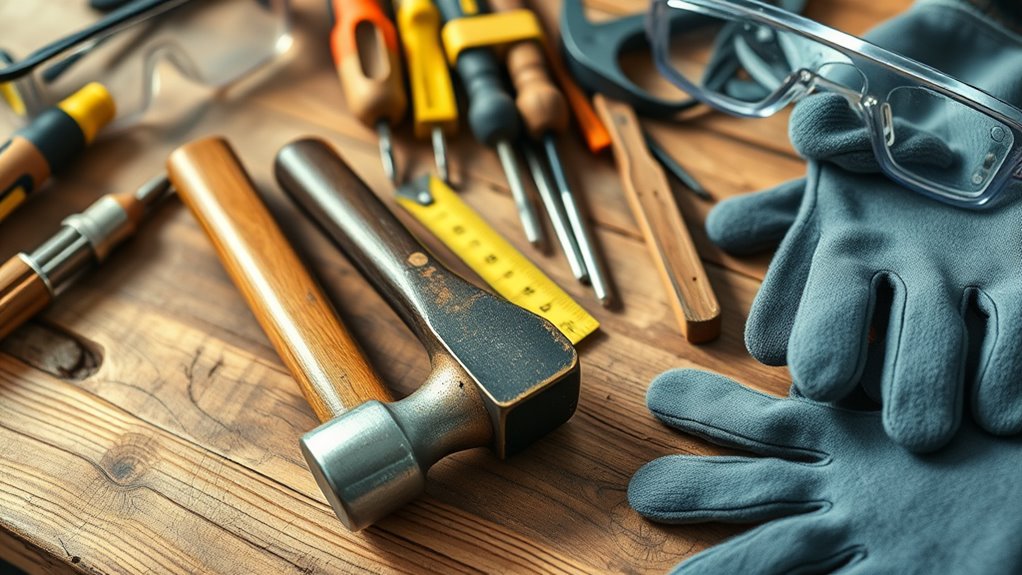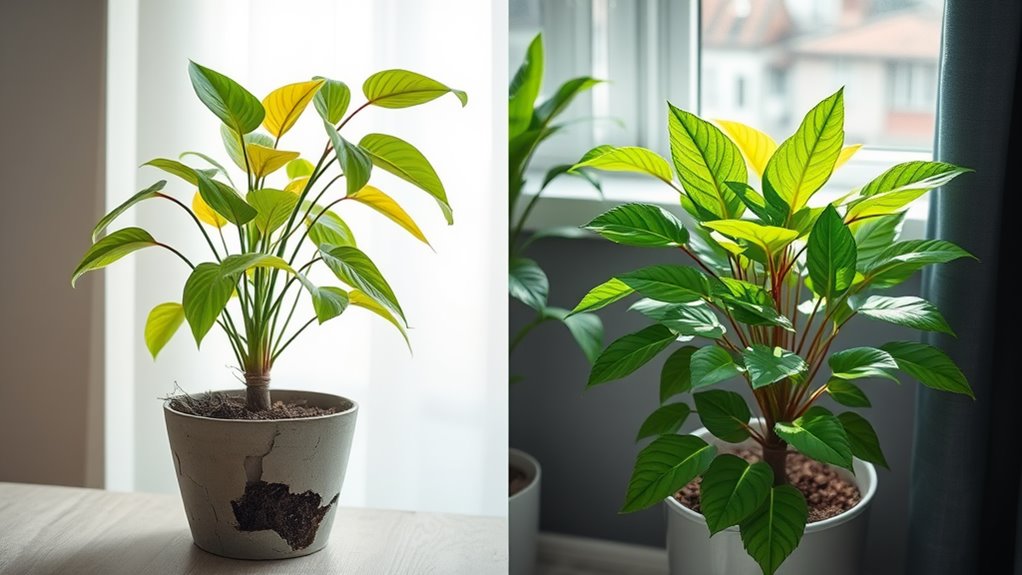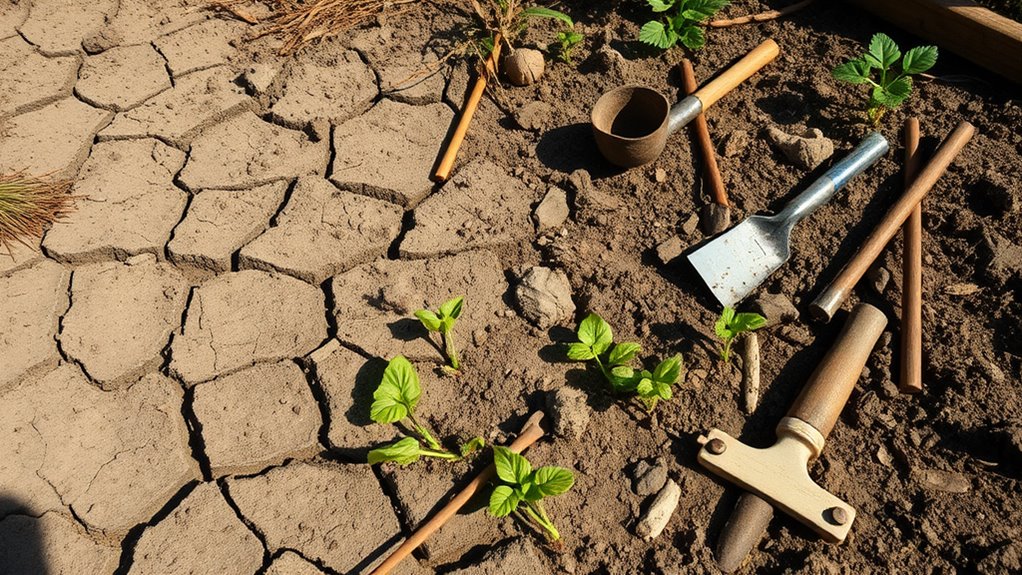What Every Beginner Needs to Know Before Buying Tools
Before you buy your first gardening tools, assess your needs and pick essentials like gloves, trowels, and shears based on your space and goals. Set a realistic budget to prioritize durable, high-quality items from trusted brands, checking reviews for longevity. Maintain them by cleaning and storing properly to extend their life and avoid common mistakes like impulse buys. Dig into more strategies to build a thriving garden setup.
Key Takeaways
- Assess your gardening needs and select essential tools like gloves and trowels based on space and goals.
- Set a realistic budget by listing required tools, researching prices, and prioritizing essentials to avoid overspending.
- Evaluate tool quality by checking materials, reading reviews, and testing for durability and ergonomic design.
- Maintain tools through regular cleaning, proper storage, and inspections to ensure longevity and prevent rust.
- Avoid impulse purchases by planning for long-term needs, reading reviews, and anticipating future garden expansions.
Understanding Your Gardening Needs
Before you buy gardening tools, assess your specific needs to ensure a smart investment.
As a beginner, you’ll want beginner gardening gear that matches your space and goals—think small plots or container setups.
Evaluate what you plan to grow: veggies demand sturdy trowels and pruners, while flowers might need lighter tools. To make informed choices, consider the top five must-have tools that experienced gardeners use for optimal results.
Consider your physical ability; choose ergonomic handles if you’re new to digging.
Don’t overlook storage; select versatile items that fit your setup without overwhelming you.
This targeted approach helps you build an efficient collection that supports your gardening journey effectively.
Additionally, prioritize must-have gear to ensure you have the basics covered for a successful start in gardening.
Setting a Realistic Budget
With your gardening needs assessed, you’ll need to set a realistic budget to make smart tool purchases.
Begin by evaluating your finances—review your income, expenses, and disposable funds to determine a comfortable spending limit.
Create a detailed list of required tools, researching their prices from various sources to estimate totals accurately.
Prioritize essentials like shovels or pruners over non-essentials to avoid overspending. To maximize savings, explore economical alternatives that can replace pricier options without compromising quality.
Factor in extra costs such as taxes, shipping, or basic accessories.
Set a firm budget cap and track your spending closely, ensuring you stay within limits for financially sound decisions.
This strategy keeps your gardening affordable and effective.
Additionally, to enhance your tool selection, explore budget-friendly tools that offer excellent value and performance for every gardener.
Evaluating Tool Quality and Durability
Once you’ve set your budget, you evaluate tool quality and durability to ensure long-lasting investments.
Start by examining materials; choose steel over plastic for better resilience against wear. Check for solid construction—seams should be tight, handles ergonomic, and finishes rust-resistant.
Read user reviews and seek warranties; they’re indicators of reliability. Test tools in-store for balance and weight to avoid fatigue.
Don’t overlook brand reputation—reputable makers back their products.
Essential Tools for Beginner Gardeners
As you dive into gardening, you’ll need a few key tools to make your efforts efficient and enjoyable.
These essentials help beginners tackle basic tasks like planting, weeding, and watering without frustration.
-
Gardening gloves: Protect your hands from blisters and thorns while working.
-
Hand trowel: Dig precise holes for seeds or transplants with ease.
-
Pruning shears: Trim plants cleanly to promote healthy growth.
-
Watering can: Deliver water gently to avoid disturbing soil or roots.
-
Garden fork: Loosen soil and remove weeds efficiently for better plant health.
Embracing a minimalist approach can help streamline your gardening experience based on simplified strategies.
To cultivate a thriving garden, these tools play a vital role in enhancing efficiency and productivity.
Comparing Brands and Options
Brand comparisons help you choose the best gardening tools without wasting time or money. As a beginner, you’ll evaluate brands by key factors like durability, price, and ease of use to match your needs. This approach saves you from buyer’s remorse and ensures long-term satisfaction.
| Brand | Key Strengths |
|---|---|
| Fiskars | Lightweight, ergonomic grip |
| Corona | Affordable, robust build |
| Felco | Precision, high durability |
| Gardena | Versatile, user-friendly |
Use this table to compare options directly, helping you decide based on what’s most practical for your gardening style.
Where to Source Quality Tools
Several reliable sources make it easy to acquire quality gardening tools.
As a beginner, you can access durable options that fit your budget and needs without hassle.
Focus on reputable outlets to ensure tools last and perform well.
-
Local hardware stores: You browse and test tools in person for immediate purchase.
-
Online retailers like Amazon: You compare prices and read reviews quickly from home.
-
Specialty garden centers: You find expert advice and niche items tailored to gardening.
-
Brand websites: You buy directly for authenticity and exclusive deals.
-
Trusted second-hand markets: You score gently used tools at a fraction of the cost.
Maintaining and Caring for Tools
Once you’ve bought your tools, you’ll need to maintain them to ensure they last.
Start with regular cleaning tips, like wiping off debris after each use to prevent rust.
Then, focus on proper storage methods, such as keeping them in a dry, organized space to avoid damage.
Regular Cleaning Tips
To keep your tools performing at their best, you’ll need to clean them regularly after each use. This prevents buildup that can cause rust, dull edges, or malfunctions, ensuring longevity and precision in your projects.
-
Wipe tools with a soft, damp cloth to remove dust and debris immediately.
-
Use mild soap or a specific cleaner for grease and grime on surfaces.
-
Scrub gently with a brush for stubborn dirt, avoiding damage to finishes.
-
Dry thoroughly with a towel to eliminate moisture.
-
Inspect for residue or early wear during cleaning to catch issues early.
Proper Storage Methods
After cleaning your tools, store them properly to protect against rust, damage, and wear that can shorten their lifespan.
Choose a dry, ventilated area to prevent moisture buildup—it’s crucial for metal tools. Use toolboxes with dividers for organization; you’ll find them faster and reduce scratches.
Hang hand tools on pegboards to save space and avoid bending. For power tools, keep them in cases or on shelves, away from dust.
Regularly check storage for issues; oil moving parts if needed. This simple routine extends your tools’ life and keeps your workspace efficient.
Ensuring Safety With Gardening Tools
While gardening tools can enhance your outdoor projects, prioritizing safety ensures you avoid injuries and enjoy a smooth experience. As a beginner, you’re responsible for protecting yourself during use. Start by inspecting tools for defects, wearing appropriate gear, and handling with care.
-
Always wear gloves, eye protection, and sturdy shoes to shield against cuts and debris.
-
Inspect tools before each use to spot sharp edges or loose parts that could cause accidents.
-
Use tools as intended to prevent strain or breakage.
-
Maintain a firm grip and stable footing to avoid slips.
-
Clean tools after use to reduce rust and handle risks effectively.
Avoiding Common Purchasing Mistakes
As you dive into buying your first tools, you’ll quickly learn that overlooking key details can lead to costly errors. One common mistake is impulse buying without research, resulting in poor-quality items that break easily. Another is selecting the wrong size or type, causing inefficiency in your tasks. To help you navigate this, here’s a breakdown of key pitfalls:
| Mistake | Risk | Solution |
|---|---|---|
| Impulse purchasing | Subpar durability | Create a shopping list |
| Ignoring reviews | Incompatible tools | Read user feedback |
| Overlooking fit | Discomfort or waste | Test and measure needs |
Planning for Long-Term Gardening Requirements
As you plan for your long-term gardening requirements, you’ll assess your future garden needs to anticipate how your space might grow.
Select tools with strong durability to withstand years of use and save you money over time.
Incorporate expansion planning strategies now, so you’re ready to add essential items as your gardening ambitions expand. Additionally, integrating time-saving tools can significantly reduce your overall gardening time.
To enhance your gardening experience, consider incorporating innovative tools that simplify planting and engage beginners.
Future Garden Needs
As you expand your garden over time, you’ll need to anticipate long-term requirements by selecting versatile tools that adapt to growing plants, larger spaces, and seasonal changes.
Think ahead to ensure your toolkit evolves with your gardening journey, focusing on flexibility and efficiency.
-
Assess space growth****: Choose tools like extendable handles to manage expanding plots without buying new ones.
-
Adapt to plant diversity****: Opt for multi-purpose pruners that handle various plant sizes and types.
-
Prepare for seasons: Select weather-resistant tools for year-round use in different conditions.
-
Incorporate new techniques: Pick items that support emerging methods, such as vertical gardening.
-
Scale with needs: Invest in modular tools that expand as your garden matures.
Tool Durability
To ensure your tools stand the test of time in long-term gardening, start by choosing materials that withstand wear and tear. You’ll want high-quality steel for blades and ergonomic handles to reduce fatigue. Regular maintenance, like oiling and sharpening, extends life—do this after each use. Focus on warranties too; they protect your investment.
| Material | Durability Benefits |
|---|---|
| Stainless Steel | Resists rust and corrosion effectively |
| Hardened Alloy | Holds edges longer against tough soils |
| Reinforced Plastic | Lightweight yet impact-resistant for handles |
Prioritize these for years of reliable service in your garden.
Expansion Planning Strategies
As your garden grows, you’ll need to implement smart expansion strategies to meet evolving requirements and maintain efficiency. This involves anticipating long-term needs like larger spaces or more plants, ensuring your tools remain effective and cost-efficient.
-
Assess your garden’s potential growth, including space and soil conditions, to avoid future constraints.
-
Choose scalable tools, such as adjustable hoes or modular planters, that adapt to increasing demands.
-
Build a flexible budget, allocating funds for upgrades without overspending.
-
Plan efficient storage solutions, like expandable sheds, to organize your expanding collection.
-
Regularly review and adjust your strategies based on seasonal changes and garden progress.





